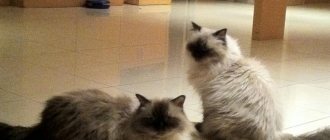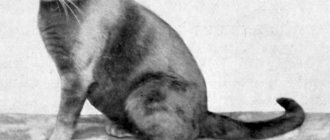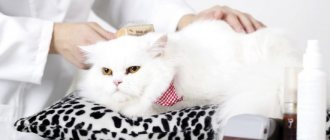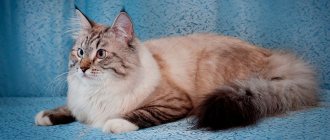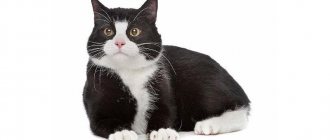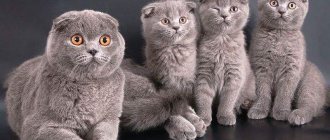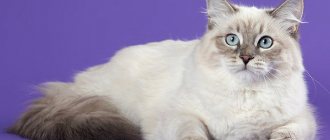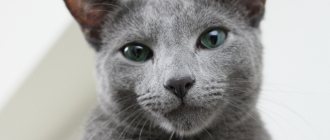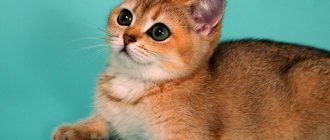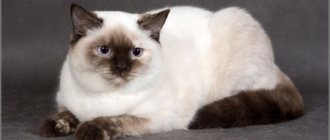What does genetics have to do with it?
Many people are probably wondering: how did it happen that all the representatives of this group are colored so uniquely? To answer this question, you will have to go back many decades and remember that cats became the object of attention of specialists in the second half of the 19th century. The British then began to perceive them as purebred animals and specially breed certain species.
The color point color is found in cats such as Ragamuffin, Highland Fold, Balinese, Siberian and American Shorthair.
The Siamese and Persian cats marked the beginning of the official registration of cat breeds. Later they became the progenitors of many modern cat breeds, including color points. Siamese cats came to Europe in 1870 and became favorites of many families. Blue eyes and unusual coloring are what attracted me in the first place.
Some scientific facts.
The color of the coat and eyes depends on a polymer pigment called melanin. It is formed from the amino acid tyrosine under the influence of the enzyme tyrosinase. It is this enzyme that is controlled by the gene that determines color, which is called Color. This gene is designated by the letter “C”. When the C gene is mutated, no active tyrosinase is produced and the pigment does not appear. In this case, the cat is born an albino, that is, uncolored. And the mutated gene is already indicated by the small letter “c”.
Where did these black spots come from then?
Scientists have discovered the Himalayan cs, or ch gene, which is also formed from a mutated C gene. But in this case, the enzyme tyrosinase becomes heat-sensitive, that is, depending on the temperature, it changes its activity: at high temperatures, tyrosinase is inactive, and as soon as the temperature drops, melanin in the cells it begins to produce and color the cooled areas of fur in darker colors. This is how the Siamese color turns out, which, by the way, is found not only in cats. In the last 30–40 years, geneticists have developed a large number of breeds that differ in color point color.
Tortoise shell (tortoiseshell, tortie)
Many randomly mixed large spots of two different colors, well delimited from each other and distributed throughout the body. There should be no spots too large or too small in the color. The nose (as well as the paw pads) should match the color - one color or another, perhaps spotted. The eyes are copper or dark orange. Possible options:
· classic tortoiseshell (tortie): the coat color is red with black spots, and the red can be of various shades. “Flames” on the sides and back are desirable, the colors should be warm and radiant;
· blue tortie, also known as blue cream (blue tortie, blue cream): The color of the coat is light blue, evenly mixed with soft cream, evenly distributed throughout the body. Small cream spots are allowed if they fit into the overall picture. The nose is grey-blue, pink or grey-blue with pink spots. The paw pads are the same. Eye color is even copper or dark orange. Excessive large spotting, dark blue or red tones in color, and a striped pattern are considered a fault.
· chocolate tortoise: milk chocolate and cream clearly demarcated spots evenly distributed throughout the body. At the same time, the cream color comes in all sorts of shades. The colors should be warm, and a tan mark on the face is desirable. The nose is milky chocolate colored, pink or milky chocolate colored with pink spots. Paw pads range from cinnamon to chocolate, pink or chocolate with pink spots.
· lilac tortie: lilac or light gray with a slight pink sheen and light cream spots evenly distributed over the entire body. A tan mark on the face is desirable. The nose is lavender, pink or lavender pink with light pink spots. The paw pads are lavender, pink or lavender pink with light pink spots.
Features of color
The color point color is determined by a gene that becomes active if it is present in both the male and female. Scientists have discovered that cats with this color are partial albinos, that is, at birth they are completely white, which subsequently acquires all the features of color point. During the first month, the dark color of the ears appears, after a month the tip of the nose begins to darken, then the entire muzzle becomes colored. For the purity of the color, the intensity of the dark spots and their contrast are important.
Areas of the body that are more susceptible to cooling (ears, paws, tail and the so-called mask on the face) become darker over time. If your cat likes to lie on the windowsill, then after a while you will notice that the color on the side of the cooler glass has become much darker. Therefore, in order to maintain the correct color, such cats need to be kept warm. There are color point breeds with different color variations.
We list the main ones:
- Choclet point (chocolate): the main color is close to ivory, the muzzle, paws, ears and tail are light brown;
- blue point: a bluish tint is the main one, all limbs, tail, muzzle and ears are painted dark gray;
- cream point (cream): the fur on the body is colored in shades of cream, everything else has a darker shade, sometimes there are dark stripes;
- tortoiseshell: tortoiseshell cats, that is, white with brown spots; sometimes it can be a combination of red, gray or cream with black;
- lilac point (lilac): cats of a cool shade with lilac spots on the face, limbs, tail and ears;
- red point (red): red spots on an almost white coat.
Color Description
If translated from English, “color” means color, and “point” means a point. Points are small dark spots located on the face, tail, paws and ears.
The usual color of a cat is solid. The pigment is evenly distributed throughout the animal’s fur and body. Therefore, you can see the uniform color of the pet.
For a color point cat, everything is completely different. Their DNA contains the cs gene, thanks to which the pigment enters only the peripheral parts of the body, that is, the cold ones. They are located at a relative distance from the warm ones. Such areas are the ears, tail, paws and muzzle.
In other parts of the body, where the temperature is relatively higher, the pigment is not able to manifest itself actively. Scientifically this is called acromelanism .
Color point breeds
Selection research by cat lovers has led to the emergence of various breeds with color point color. They differ from each other not only in the shade of the color dots, but also in the basic tone. Let's list the main color point cats. The well-known Siamese color is called seal point. It should be noted that in America such cats are called Himalayan, because a similar color was known in Himalayan rabbits.
If a cat has a pair of Himalayan genes in its cages, then its fur on its limbs, tail and face will be dark brown. These spots do not turn black because the enzyme tyrosinase in Siamese cats is not active enough, and the formation of melanin does not occur so intensively as to polymerize. The eyes of Himalayan cats should be blue due to the small amount of melanin in the iris. The richer it is, the more purebred the cat is considered.
Its relative, the Thai cat, is very similar to the Siamese cat. It has many varieties, depending on the predominant shade. But they are united by one feature: the body has a certain color, and the limbs, ears and muzzle will always be painted darker. The Thai cat was bred using selective selection, as a result of which some characteristics of its ancestor, the Siamese cat, were changed:
- muzzle shape;
- color;
- body shape.
The Thai breed cat standard was officially adopted in Germany in 1990.
Let's compare cats of both breeds and determine what their differences are:
- The Thai cat looks much more massive, the Siamese has an elongated, graceful body.
- The Thai's muzzle is round, while the Siamese's is elongated.
- The Thai cat has rounded eyes, while the Siamese cat has pointed eyes.
- Thai cats have short and powerful legs, while Siamese cats have long legs.
The common features of all representatives of the Thai cat breed are affection and complaisance. They quickly become attached to their owners and can follow commands that they have been taught. They love to communicate: they meow and purr to carry on a conversation with their owner. But try not to offend them, as they remember the insult for a long time and can take revenge. Externally, Thai cats look very elegant: the muscles are well developed, the head is round, the eyes are blue, the coat is soft without undercoat. Their weight and size can reach 3 kg.
It will be interesting to learn about such an unusual breed as the Snowshoe.
The Red Point is a Thai cat with a white base color and a red tint on the legs, face and ears. Caring for and maintaining the Thai cat breed is not particularly difficult, as they are usually healthy, not susceptible to any special diseases, and their fur does not require combing. You can use standard food - either natural products or dry food and mixtures
Persian color point
Among all color-pointed cats, fluffy semi-longhaired and longhaired Siamese cats stand out noticeably. In 1931, American scientists set themselves the task of breeding a Persian cat with a Siamese color. They bred a purebred black Persian cat and a Siamese cat.
For more than 20 years, by crossing the brightest representatives of litters from Siamese and Persian cats, scientists achieved the birth of a pure breed Siamese-Persian cat, which combined the Siamese color and blue eye color with the nose and ears of the Persian breed. In 1955, the Persian Longhaired Color Point received official recognition. By the 70s of the last century, color point cats acquired a look more characteristic of Persian cats
British color point
Relatively recently, a British cat with color point color was bred. Let us remember that in America these representatives of the cat world are called Himalayan. The British Color Point is painted in light colors; limbs, tail, ears and muzzle contrast with the main color and have a dark tint. Their eyes are dark blue or deep blue. The Briton's coat is dense and dense.
Did you know? British Color Points are born albinos, and only after a few weeks do they show the well-known dark spots. Young cats always have a more pronounced color than adults.
The character of British Color Points is independent, but calm. They get along well with all household members and require a lot of attention and love. They have a developed hunting instinct: these cats are able to catch mice. If a Briton has a white coat with light blue markings, then he is called a blue point. The coat of a British cat has 2 levels: a dense undercoat, reminiscent of plush, and long guard hairs. Therefore, it requires special care.
Find out what gray, red and tabby cats they are.
To maintain the healthy appearance of such a coat, a Briton’s diet must certainly include calcium, essential vitamins and microelements.
A British cat should be checked for tangles in its fur and should be constantly brushed with a massage brush. When washing, use shampoos for short-haired cats. If you have British kittens, then they need additional care:
- wipe the eyes with a damp cloth from time to time to remove any accumulated secretions;
- ears are cleaned of accumulated wax;
- check for the presence of ticks in the fur;
- Nails are trimmed with a special nail clipper.
British Color Point kittens can be toilet trained. The tray designated for this should be in a secluded place and should be cleaned in a timely manner.
Scottish straight
Scottish Straight cats were bred in Scotland and are also called Scottish Straight cats. They were the result of crossing a Scottish fold cat with a straight-eared cat. Scottish Straight kittens until they are one month old have ears like their fold-eared ancestor, after which they straighten out and become straight.
This representative of the color points is characterized by features that are unique to him, in contrast to the British, with whom he may be confused:
- the head shape is more round;
- the body is elongated, graceful;
- significantly lower weight than the British (no more than 5 kg for a cat and 3.5 kg for a cat).
To accurately determine whether the cat you have in front of you is indeed a Scottish Straight cat, use the standards of this breed:
- the head is round on a thick neck; the forehead is slightly rounded, high and convex;
- the eyes are wide and round in shape;
- medium sized body;
- well developed chin, round muzzle;
- the nose is wide, small, has a depression along the entire height of the nose up to the forehead (visible in profile);
- The ears are wide at the head, rounded at the tips.
- the paws are developed in proportion to the body, the tail is long, narrowed at the end.
- the coat has a pronounced undercoat, the guard hairs can be long or short.
Scottish short-eared cats are distinguished by a good-natured disposition, do not require much attention to themselves, prefer to be close to the owner, and do not like to sit on hands. They become attached to one member of the family, but are peaceful with everyone.
Maintenance and care
Almost all breeds with this color are more valuable when the contrast between the base color and the pigment parts is strong. Therefore, the main task of a person is to maintain the correct color. In addition to temperature, other factors also affect color.
The first one is age. Almost every cat darkens over time . The pet’s diet can also greatly affect the color. An indisputable fact is that carrots and seaweed, which contain a lot of iodine, can change the color of an animal. You should be careful about the composition of the feed. It is not advisable to give your cat vitamins that contain seaweed and kelp. You should not feed foods containing a lot of copper.
Experts have noticed that Thais begin to quickly turn dark when eating beef, any seafood, liver and buckwheat. If there is a predisposition, then the best solution would be to use special feed.
Any damage can also change the color of fur and even skin. In areas where injury or surgery has been performed, the fur will be much darker. This is due to the fact that that area of the body will become much colder. In some cases, color may return after the first molt, but this does not always happen.
If you definitely need to have surgery, then it is advisable to choose a place that will be least noticeable. After the procedure, it is necessary to carefully wrap the incision until complete healing.
We must not forget about trimming the claws. This should be done so that the pet cannot hurt itself.
Color point groups
Solid colors
Surprisingly, color point cats also come in solid colors. In this case, the characteristic markings on the coat are colored the same and do not have any white inclusions or patterns. The pads on the paws and the nose are the same color as all the markings on the body.
Read the basic rules for choosing dry cat food.
Shedded point and chinchilla point
A variety of colors is also considered to be shaded, otherwise this color is called shedded point. In this case, cats have a light undercoat, shaded hair on the sides of the body, on the back, head, ears and tail. On the belly, in the chin area and the bottom of the tail, the fur is light in color. Thus, any of the primary colors of the color is present only in the upper part of the hair. If 1/8 of the length of the guard hair is colored, and the rest remains white, then such a cat has a chinchilla point color.
Cats of this color have three varieties:
- silver chinchilla;
- golden chinchilla;
- Blue golden chinchilla is the rarest color in cats.
Silver
Among the shaded colors there are:
- shaded golden;
- shaded silver;
- shaded red.
Cats of these colors should not have a clear pattern, but may have the letter M on the forehead and dark rings on the paws.
Tabby point
This is an interesting color in which the cat has a pronounced pattern on its forehead, reminiscent of the letter M. The area around the eyes and whiskers contains distinct spotting. On the front paws there are torn rings that extend from the toes upward; the hind legs are solid shade. Stripes are visible on the hips. In this case, the ears are colored the same tone, but there is always a lighter mark on the outer part of the ear.
A characteristic feature of the tabby point color is the inevitable presence of red or cream spots on the ears. The mirror of the nose is painted pink. When a cat’s genotype contains the tabby gene (responsible for the presence of stripes), then the prefix “tabby-” is added to the name of any type of color. For example: seal tabby point, blue tabby point, red tabby point, etc. It should be noted that stripes are visible only on colored points, as a result of which this color looks very delicate.
Tortoiseshells
The next variety of color point is the tortoiseshell color, which is scientifically called “tortie” (remember the well-known turtle Tortila from the fairy tale?). With this color, the spots have a reddish (red) or lightened cream color, which looks quite contrasting against the general background. These cats are called happy cats because of their tri-colored tortoiseshell coloration, which contains black (or blue), red (or cream) and white.
Caring for cats is very important, so take care of how to choose a house, sew a blanket, make a scratching post, choose a name, toy, litter, carrier and furminator.
Appearance
Today, color point cats differ significantly from those that were obtained as a result of the first experiments. The structure of their coat and body structure are very similar to Persians.
The body is squat, muscular, with a broad, massive chest and well-developed shoulders. The limbs are squat and stable. The tail is of medium length and unusually fluffy.
On a round, proportional head, under long hair, small ears with rounded tips are almost invisible. They are located quite low and widely spaced. The round cheeks and developed chin are clearly visible on the muzzle.
Large, round, very expressive eyes are set widely apart and most often have a bright blue color.
Luxurious wool is another distinctive feature of this breed. Its length can reach up to 12 cm. The wool is very thick, thin, and has a silky structure. It forms a chic collar on the neck and chest.
The color of the breed is determined by the color of the spots. The most popular is with brown, almost black, markings. At the same time, the general background is light, almost white. There are cats with blue and lilac markings.
Depending on their color, all representatives of the breed are divided according to color into groups called:
- Blue Point
- Chocolate point
- Lilac Point
Personality traits of the British Shorthair cat
Despite the fact that British Shorthair cats tolerate loneliness quite painlessly, they yearn for an absent owner. Preferring independence, cats of this breed become attached to one person.
The cat prefers to avoid strangers, occasionally responding to obsessive attention with aggression. Possessing self-esteem, representatives of the British Shorthair are extremely restrained and not intrusive.
They have a minimal need for affection from their owner. He has a calm disposition and even in the event of aggression, he does not immediately use his claws, but only warns with a blow of a soft paw.
If there is a special claw scratcher, the cat, due to its good manners, will not damage the furniture. She is very selective in choosing her favorite places, which are always central in the home.
Representatives of the breed are very playful and prefer to have several toys. They respond well to training at an early age; it is almost impossible to retrain an adult cat.
The “British” devote quite a lot of time to their appearance, carefully licking themselves throughout the day. There are no problems when toilet training a cat, since this breed is very clean and the only nuance may be the individual selection of litter for the tray.
Owner reviews
I could never imagine my life without some animals. I always considered everyone I had as part of the family. The cat was bought about 5 years ago. He was about a month old then. He didn’t even know how to feed himself or go to the toilet yet. Most likely, the seller needed to sell the cat as quickly as possible, so he lied a little about the baby’s readiness for independent life. In general, the kitten was named Bonya.
Color point cats are very cute and gentle kittens, and adult cats too. They are quite interesting to watch. They are funny, active and cheerful.
We bought a British Shorthair as an adult. At that time she was 10 months old. She is very clingy by nature and loves a lot of human attention. She herself jumps into her arms, but only in those cases when she exactly wants it. You can squeeze for hours, the cat is very patient.
We have a Sphynx Peterbald cat. They set up a special place for her to sleep, but she only sleeps there during the day. At night he always comes to my bed.
How to choose the right kitten
To avoid being deceived, it is advisable to buy a Himalayan kitten from trusted breeders or certified nurseries. Before concluding a transaction, you must make sure that you have a veterinary passport with vaccination marks and documents confirming your breed.
It is also advisable to pay attention to the behavior and living conditions of small Himalayans. Kittens should be inquisitive and playful. And the room where the Himalayans live should be warm, light and clean.
It is important that kittens do not have fleas, bald spots, scratching, unpleasant odor from the mouth and dirt under the tail. Healthy Himalayans should have a soft coat and clean eyes and ears.
Kitten care
Himalayan kittens from good nurseries go to new homes no earlier than they are 12 weeks old. By this point, they are already eating a variety of foods on their own, know how to use a litter box, and are accustomed to a scratching post. Therefore, the owners only need to wait until the little Himalayan gets comfortable in the new place and show him where he can eat and relieve himself.
Owners must take care of the kitten's safety in advance. To ensure that the Himalayan does not suffer from his own curiosity, large equipment and windows are covered from him, and household chemicals, small items, indoor plants and wires are also hidden.
To prevent the kitten from developing digestive problems amid the stress associated with the move, at first it is fed what it is accustomed to. New foods are introduced into the little Himalayan’s diet gradually to monitor the body’s reaction. The feeding schedule is based on the age of the kitten:
- up to 12 weeks – 5-6 times a day;
- 3-6 months – 4 times a day;
- 6-12 months – 3 times a day.
An adult Himalayan cat is switched to twice feeding.
